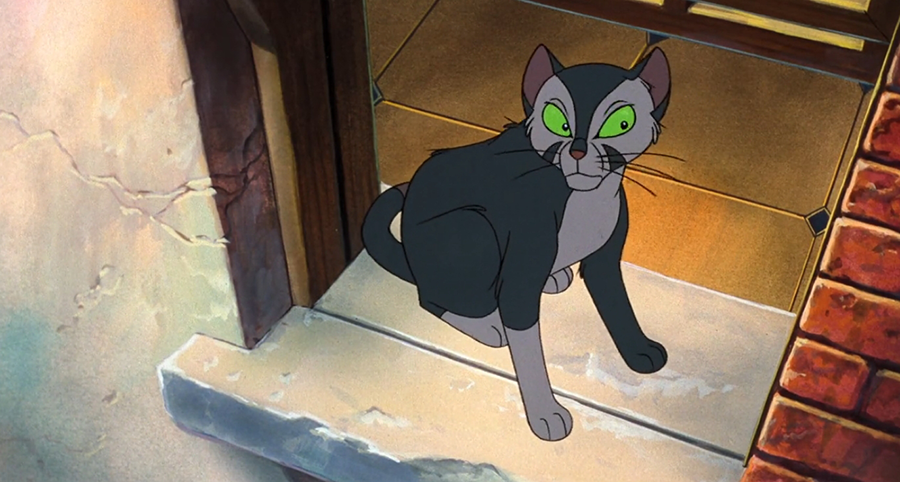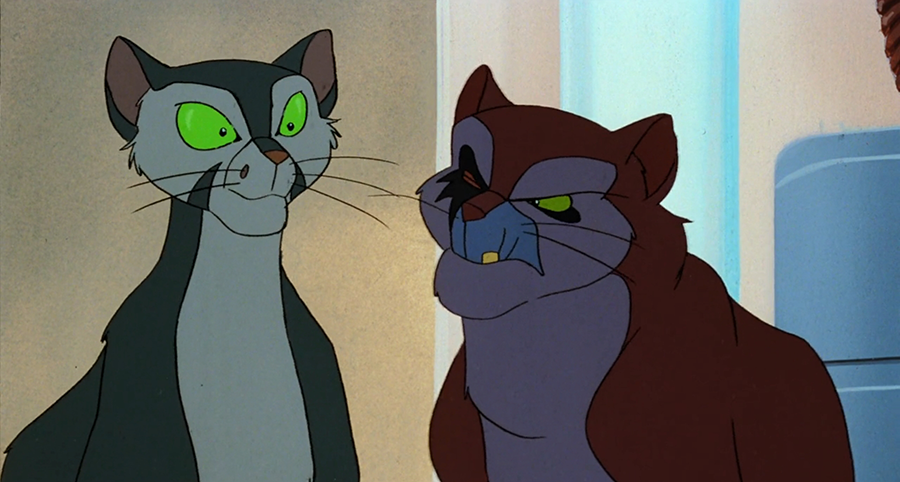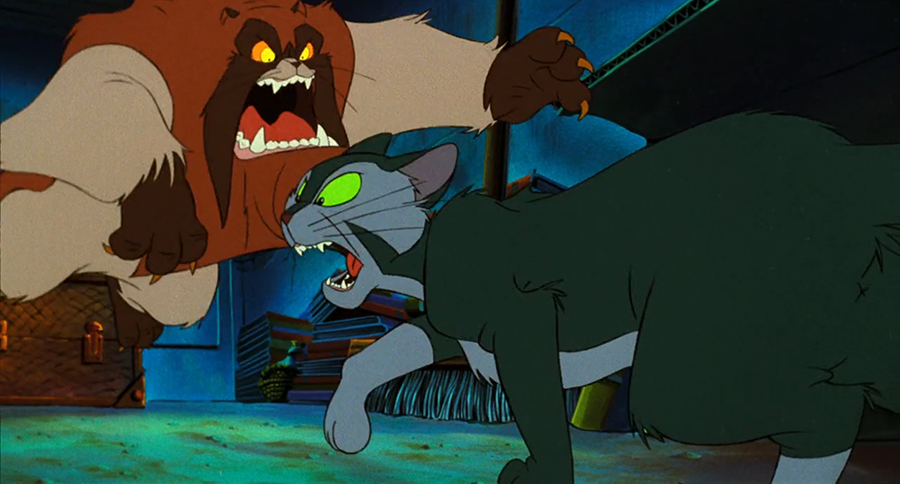FELIDAE
Directed by Michael Schaack. 1994. Germany.

Francis and his life partner, Gustav, have moved into a new house. While Francis is bothered by the smell of mold and the tedium of moving, Gustav, an author, views the ordeal as the prelude to a new experience. And a new experience is precisely what Francis gets when he discovers a corpse, its neck mutilated, and a gruff, one-eyed stranger near the body. The stranger tells Francis that his name is Bluebeard and that this is not the first body to turn up, but the fourth. All of the victims died from the same vicious trauma to the neck.
The gruesome discovery latches onto Francis’s mind. At night, he has a terrible dream about a faceless man in a doctor’s jacket. Understandable, I suppose. Their new house was once a doctor’s office, and the smell of chemicals still lingers in the air. Francis convinces Bluebeard to take him to see the corpse of a previous victim. Maybe, Francis surmises, he’ll be able to put two and two together if he sees it. Along the way, the pair runs afoul of the brutish Kong and his pair of minions. After an exchange of words, Kong promises that they’ll meet again for a fight.
Francis and Bluebeard arrive at the old crime scene. The corpse lies on top of a motorcycle, its neck torn out. Francis begins to do the mental calculations, coming to a swift conclusion. You see, Francis tells Bluebeard, the killer attacked their victim outside. Mortally wounded, the victim dragged himself to the motorcycle and then died. But why attack him at all? The killer is in heat, Francis explains, and so were the victims. These serial killings are merely a way to eliminate competition. Bluebeard balks. He believes it to be the work of a can opener, those vicious two-legged bastards. No, Francis, tells him. The injuries are not the work of a human. No, the wounds on the victim’s body are clearly bite marks.

Oh, did I fail to mention that all these characters are cats?
That’s the twist in Michael Schaack’s impeccable adaptation of Akif Pirinçci’s cult novel. It’s a concept that would make even Ralph Bakshi think twice. It’s a crude, sometimes homophobic, frequently distressing work that will send anyone skittish about animal violence running for the hills. It’s also the closest you’ll ever get to a proper giallo film populated by talking animals. The amateur detective, the “damned indomitable curiosity” that plagues the hero, the helper character, the seductive female who may or may not be trouble, the rooftop chases and nasty fisticuffs, the past traumas motivating the killer, the red herrings, the MacGuffins, the fake-out ending, the solution that we swear was obvious the whole time… It’s all here. If Satoshi Kon’s PERFECT BLUE has you hankering for some more animated giallo-esque thrills, FELIDAE will definitely satiate that craving.
To this point, FELIDAE has been a simple story of sex and serial murder. But the narrative turns a sharp corner when Francis discovers a suicide cult conducting a ceremony on the upstairs floor of his new home. Cats willingly walk into a deadly electrical current as the cult leader, Joker, preaches about a mythical feline named Claudandus who escaped death at the hands of humans and became a god upon ascending to heaven. After being spotted, Francis is chased along rooftops by the cult, eventually escaping through an open skylight into the home of Felicity, a blind cat who claims to have heard the death cries of the victims and the mating calls that preceded them. Once the coast is clear, Francis heads home, but not before telling Felicity that he’ll return to her.
Francis and Bluebeard visit Pascal, an elderly cat living with a doctor. Pascal has been using his human’s computer to keep a database of all of the cats living in the area (cats using technology and reading human languages are two logical concessions you’ll need to make). Pascal helps them see the pattern. All of the previous victims were European shorthairs. The latest victim, however, was not. Francis is horrified to learn the identity of the last reported victim of the killer: poor, blind Felicity. Was she killed for knowing too much?

Unable to sleep, Francis takes to hunting rats in the basement. It’s here he stumbles upon yet another piece of the puzzle: an old videotape chronicling a series of cruel experiments on stray cats by Doctor Preterius, a medical researcher attempting to create a tissue adhesive that could treat wounds in an instant. Only one cat survived these experiments (and the many that came after). That cat outlived its cruel tormenter, and maybe even caused his death. In fact, that cat might very well be the one responsible for the rash of murders plaguing the city.
From a horrifying nightmare sequence of Gregor Mendel puppeteering the rotting corpses of a hundred slaughtered cats to the realization that racial purity and eugenics experimentation is at the heart of the killing spree, the final third of FELIDAE goes straight for the throat in as unsubtle a way as possible. It’s here that I began to realize why this was a movie of talking cats instead of talking human beings. Anthropomorphic animals allow for a certain degree of separation and abstraction. The use of cats created distance, not just for the audience but for the filmmakers and investors. Without the change in species, it’s hard to imagine FELIDAE being palatable to its native German audience. It's talk of racial purity and selective breeding, and gross displays of religious fanaticism and scientific experimentation might have struck too raw a nerve, even in the 1990s.
Not that the use of talking cats blunts its message or moral quandaries. Does it really matter if our hero fighting for an inclusive society has paws or if the villain attempting through murderous means to breed a superior race of cats to wipe out all humanity has whiskers? Not really. The dramatic weight of history is enough to pull us through the fantasy. A call for racial purity is disgusting, regardless of the species of the individual attempting to enact it.

If the subject matter isn’t a turn-off for you, the level of violence might be, especially if (like me) you’re a cat person. The shock is eased a little by the fact that many of the cat characters aren’t very catlike in appearance. That said, this is still a graphically violent film. The spilling of intestines, the shocking discovery of a decapitated feline, and the cruel experimentations are all drawn far more realistically than most of the chase scenes and moments of conversation. Francis’s nightmares, for example, are absolutely horrifying creations, with a level of detail that far exceeds the quieter scenes that bookend them. This might have been a creative choice or the result of using numerous creative studios instead of a single animation department. The quality of the animation varies from scene to scene.
The characterization, however, is spot on, with each cat feeling as unique and well-defined as the last. Personalities are clear, arcs are well-structured, and the mystery narrative is compelling and troubling in equal measure. FELIDAE easily transcends the throwaway label of “adult animation”. It isn’t a novelty or a gag film. No, this is a well-oiled mystery-thriller with moral and philosophical depth. I was thoroughly stunned by it, dragged kicking and screaming through its depths. I came out the other side with a tinge of hope. The story doesn’t end in bleak, unforgiving darkness, even it makes frequent trips there. FELIDAE is not for kids, obviously, but it’s definitely for people with a taste for dark European thrillers and giallo films. I felt at home with it and repulsed by it in equal measure, but I was never once anything less than captivated by it.